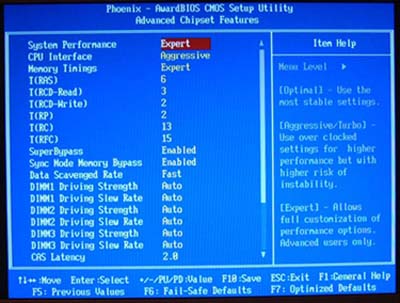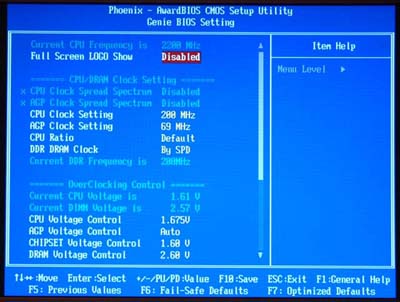DFI NFII Ultra: Mean Green Dream Machine
by Wesley Fink on July 30, 2003 6:25 PM EST- Posted in
- Motherboards
DFI NFII Ultra: BIOS and Overclocking
DFI uses the familiar Award BIOS on the NFII Ultra. Our test board was equipped originally with the 6/05/2003 Performance BIOS. While we were impressed with the incredible array of options available in this BIOS, we had some problems with the stability of the BIOS in some extreme overclocking situations. The later 6/25/2003 BIOS proved to be fast and very stable, and thus, benchmarks were run using this BIOS.DFI later supplied an updated 7/10/2003 Performance BIOS, which proved to combine the excellent stability of the 6/25/2003 BIOS with the incredible selection of tweaking options available in the 6/05/2003 BIOS.

The Performance BIOS has the most incredible array of overclocking options that we have ever seen on an nForce2 board.
FSB - 100-300 in 1MHz intervals
AGP - Auto or FIXED at 1Mhz intervals from 50-100
CPU Ratio - 5X-22X
vCore - Auto, 1.10-2.05 in 0.025v increments
vAGP - Auto, 1.5-1.8 in 0.1v increments
Chipset Voltage - Auto, 1.6-1.9 in 0.1v increments
vDIMM - Auto, 2.5-2.8 in 0.1v increments
RAM Ratios - Auto, 2:1. 5:3, 3:2, 4:3, 5:4, 6:5, 1:1, 5:6, 4:5, 3:4, 2:3, 3:5, 1:2
T(RAS) - 1-15
T(RCD-Read) - 1-7
T(RCD-Write) - 1-7
T(RP) - 1-7
T(RC) - 9-31
T(RFC) - 9-31
Super Bypass - Enable, Disable
Sync Mode Memory Bypass - Auto, Enable, Disable
Data Scavaged Rate - Fast, Normal
DIMM 1 Driving Strength - Auto, 1-15
DIMM 1 Skew Rate - Auto, 1-15
DIMM 2 Driving Strength - Auto, 1-15
DIMM 2 Skew Rate - Auto, 1-15
DIMM 3 Driving Strength - Auto, 1-15
DIMM 3 Skew Rate - Auto, 1-15
CAS Latency - 2.0, 2.5, 3.0
The options available in the Performance BIOS are certainly a demonstration that DFI does know what is involve in producing a board squarely aimed at the computer enthusiast. How can you not be impressed with an enthusiast's dream collection of tweaking options in the Performance BIOS available for this board?

The voltage adjustments, FSB adjustments, and ratio controls are in a menu item DFI calls “Genie”.
We can tell you the added options do make a difference in squeezing every bit of performance from the NFII Ultra, but we have only scratched the surface in mastering the available tweaks. The speed and overclocking abilities with this BIOS are impressive. A word of caution here also: you can get yourself into trouble with the available options if you're not careful. If you don't understand these options, choose AUTO; otherwise, you may be reformatting your hard drive. The 6/25/2003 release version of the BIOS includes a full array of options, but does not include all these options; rather settling for optimum values for most situations. But AMD tweakers will love this Performance BIOS.
The NFII Ultra PC Health section includes System and CPU temperatures, CPU and Chassis fan speeds, Vcore, and Power Supply readings for all rails. There is also an adjustable setting for Maximum CPU temperature that will automatically shut down the system, if the preset temperature is exceeded. DFI includes the familiar Winbond Hardware Monitor for keeping tabs of voltages, temperatures and fan speeds in Windows.
Voltage adjustment options for the DFI NFII Ultra are very well-balanced. We were pleasantly surprised to see vCore adjustments to 2.05V – much higher than offered by most other nForce boards, except those from Epox. The vDIMM adjustment range, while much better than the DFI 975PRO LanParty, tops out at 2.8V. Although this should be adequate for most users, we are now seeing new high-speed memory from OCZ and GEIL that offers warranty support for use at voltages up to about 3.0V. We would have preferred to see the vDIMM reach to the 3.0V to 3.2V range, but in reality, we will not be running nForceII boards at DDR500 as we might on an Intel 875P board. Considering the practical overclocking limits of the nForce 2 Ultra 400, we would conclude that the 2.8V maximum voltage for memory is probably a good choice. Besides, we have chipset voltage adjustments on the NFII Ultra – all the way to 1.9V. In testing overclocks on the NFII Ultra, we found that we often attained better results getting beyond walls by increasing the chipset voltage a bit, rather than increasing vDIMM. Certainly, the wide chipset adjustment range coupled with the decent vDIMM adjustment range gives the overclocker many very effective options.
FSB Overclocking Results
For FSB overclocking, the following setup was used on the NFII Ultra:| Front Side Bus Overclocking Testbed | ||
| Default Voltage | Maximum Overclock | |
| Processor: | Athlon XP 2500+ (Barton Core) | Athlon XP 2500+ (Barton Core) |
| CPU Vcore: | 1.65V (default) | 1.775V (default) |
| Cooling: | Thermalright SK-7 with 80mm Thermaltake Fan | Thermalright SK-7 with 80mm Thermaltake Fan |
| Power Supply: | Powmax 350W | Powmax 350W |
The above overclocking setup at default voltage allowed us to reach a stable FSB of 223MHz. This makes the DFI NFII Ultra the best overclocking nForce2 Ultra 400 board that we have tested at AnandTech. With this kind of performance at default voltage, we were curious just how far we could push the Barton 2500+ with a bit more voltage. We were able to achieve complete stability at 227MHz using 1.775V. This represents a true CPU speed of 2.502GHz from a chip designed to run at 1.83GHz – a 37% overclock. Since the 3200+ runs at 2.2GHz, this would represent a performance rating in the range of 3600+, if such a rating existed.
The DFI NFII Ultra has a very wide range of multiplier adjustments, available from 5.5X all the way up to 22X. The whole range of multipliers appeared to work well on our Barton 2500+. We did not see any missing ranges in the multiplier settings, as have been reported on other nForce2 boards.










46 Comments
View All Comments
Anonymous User - Thursday, July 31, 2003 - link
Anyone else having a problem seeing the images containing benchmark results? The Gigabyte board review had the same problem.Anonymous User - Thursday, July 31, 2003 - link
>Besides, nvidia is no longer the standard for performance, in fact they are becoming the (Trident) of the video card market.Can you say "drooling ATI fanboy"? I knew you could!
Anonymous User - Thursday, July 31, 2003 - link
errr that should be "new" not "knew" in comment 16....i'm sure i misspelled some other things too, which y'all are welcome to point outAnonymous User - Thursday, July 31, 2003 - link
hey guys as wesley stated, he's knew to AT...let's give him some constructive criticism - preferably in as nice a way as possible ;)to wesley, please don't take the comments here the wrong way - i think everyone here just wants to see quality reviews here and really are trying to be constructive, even if it doesn't really sound like it all the time ;) you have high standards to live up to at anandtech and when ya slip, they're gonna let ya know ;)
Anonymous User - Thursday, July 31, 2003 - link
I think you guys are being a bit hard on this review. Granted posting benchmarks comparing 2 different motherboards with 2 different video cards is just wrong but give them a chance to fix it.Sammual
Anonymous User - Thursday, July 31, 2003 - link
Anandtech is starting to lose my respect! Were you guys payed to make the board look good?If the video cards aren't the same then there should be no gaming benchmarks!
Peace
Anonymous User - Thursday, July 31, 2003 - link
I completly agree with number 8 above, there are a few primary boards that are the most popular, ASUS and EPOX being the main ones. I personally do not know anyone that uses a gigabyte nforce2 based board for their AMD chips. Heck that Gigabyte board you tested with was not even a consideration when I was looking for my nforce board.Besides the proofing issues involved in this article, it just would have been nice if you used the top tier of nforce boards as a comparison.
Also, why on earth are you guys still using nvidia based video cards for testing purposes????
In your attempt to keep us up to date and advised properly on new products and specially benchmarks, you should atleast keep your hardware up to date. Besides, nvidia is no longer the standard for performance, in fact they are becoming the (Trident) of the video card market.
Evan Lieb - Thursday, July 31, 2003 - link
Jeff7181,It's already been proven that nForce2 Ultra 400 motherboards are faster than KT600 motherboards. This DFI review wasn't meant to prove that again.
Yes, this review used the 9800 Pro instead of our usual Ti4600. We're sorry about that, as we're currently transitioning our motherboard testbeds. Be patient and you'll find data comparing KT600 and nForce2 Ultra 400 boards using a 9800 Pro like we normally do.
Take care,
Evan
Odeen - Thursday, July 31, 2003 - link
Once again, we have fluff on the PCI bus that doesn't belong there... Why not just put a PHY that implements the 3Com MAC on the southbridge, instead of stealing PCI bandwidth and adding extra componentry.As awful ad 3com drivers might be, they still beat the processor hogging "win-NIC" that is Realtek.. The only saving grace is the use of the Cmedia codec for the Soundstorm. While not on par with Asus' implementation of the A7N266-C (ACR card with Sigmatel codecs, as far away from the motherboard as possible), it at least beats the godawful ALC650..
(Before you jump on me with the Dolby encoding. DD is LOSSY as well, if you read 3dsoundsurge review of the Soundstorm audio, you'll find out that in DD encoding mode, you lose all frequencies over 18,000).. Granted, with all the fans yer average overclocker has, they don't really have the hearing to experience 18,000 hz, but it's still nice to know it's there :)
Anonymous User - Thursday, July 31, 2003 - link
I would like to add a point about the exclusion of gigabit lan on the DFI NFII Ultra LanParty mainboard. Although gigabit lan would be a nice feature for an enthusiast, adding gigabit lan in place of dual megabit lan would alter nVidia's original marketing strategy for the NForce 2 chipset. Remember nVidia was touting "DualNet" as a great feature of NForce 2? Well, here is a reminder:"DualNet
Part of the nForce2 Digital Media Gateway. DualNet is integrated support for an NVIDIA Ethernet Mac and for a 3Com® Ethernet Mac—allowing a PC to serve as a home gateway, managing traffic between two separate networks and ensuring rapid transfer of data from WAN to LAN without any added arbitration or latency."
So, DFI was just following along with the nVidia strategy. Besides, where are you going to put gigabit lan on this board? On the pci bus? You would saturate it. You need some bus which can handle a minimum of 133 MB/s throughput, like CSA, to get the full benefit of gigabit lan.